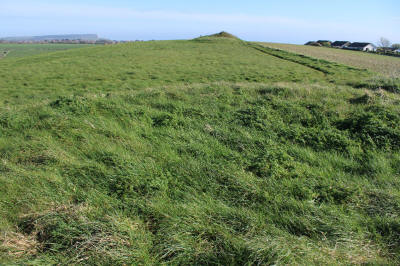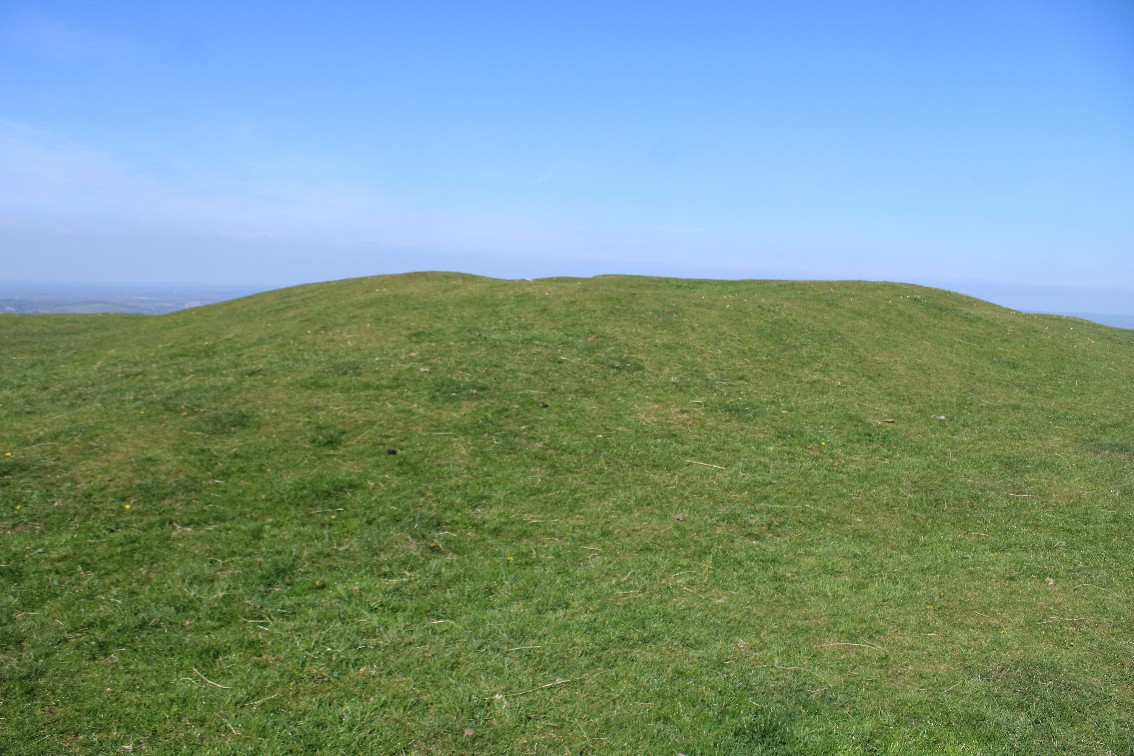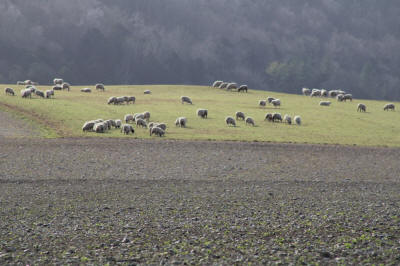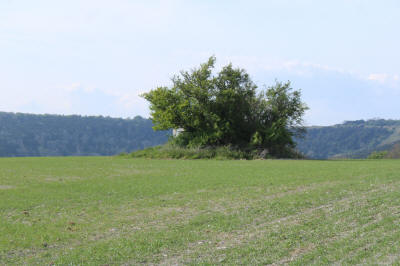|
  |
|
Page 2 |
Newsletter 139 Winter 2022 © Hampshire Mills Group |
|
Barrow Mills
Sussex Bronze Age
barrows used as windmill steads
Alex Vincent
|
|
A number of Bronze Age barrows were later reused as
mill mounds or windmill steads mainly in the
medieval period. The roundness of barrows was
adequate for a windmill to be placed upon them.
There are a number of examples throughout Britain,
but the Bronze Age barrows at Mill Barrows at
Beauworth in Hampshire (OS
grid reference SU 572 243)
may not have been associated with a windmill. The
name could have derived either from the Anglo-Saxon
‘mylen beorh’ (mill barrow) or an Anglo-Saxon name
Maegla. It seems that only the bowl barrows (the
most numerous of their types) were used as windmill-steads.
These windmills would have been open trestle and
sunken post mills.
In the 18th and 19th centuries, during excavations
of some barrows, stone foundations, and timber
structure remains of post mills were found. These
were not identified as mill remains until the early
20th century. Charles Monkman was one of the first
to discuss some of these cruciform structures found
in East Yorkshire. L V Grinsell studied about
10,000 barrows during the 20th century and has
stated which ones were later reused as windmill
steads and some possible cases of re-use.
Some examples of mill barrows in Sussex are at
Houghton, Bury Hill, Parham, Glynde (2), Firle (3),
Beddingham (2), Summer Down in Newtimber, Piddinghoe,
Stoke Down at West Stoke, Plumpton, and on Rookery
Hill at Bishopstone. There is little information
about most of these windmills as most of them went
out of use centuries ago, but some of the later 18th
and 19th century mills may have been built on the
same site. Below are a few of the barrows which
later became windmill steads.
Beddingham Hill (OS
grid reference TQ 453 060)
Two of the Bronze Age barrows on Beddingham Hill
later became windmill steads. A windmill was marked
on the Spanish Armada map of 1587 as ‘Beringham
mille’. The mill was situated on the hill just
north of the South Downs Way. There are no records
of the mill after 1813 and it probably fell out of
use by then. A mound where it once stood marks the
site today. This is marked on the modern OS
Explorer maps as ‘Mill Mound’. This may have been
one of the windmills, which used a Bronze Age barrow
for its base.
|
|
Bishopstone (OS
grid reference TQ 467 008)
A group of five bowl barrows exist on Rookery Hill,
which date from about 1600 BC. They form a
south-east to north-west alignment. The
south-eastern barrow is the largest of them,
measuring 18 metres in diameter and one metre in
height. A ditch surrounds it. The second barrow
going northwards was used as a windmill stead in the
Middle Ages. There is a wide hollow where the
windmill once stood. The medieval windmill at
Bishopstone is one of the earliest recorded in
Sussex.
|
 |
|
Bury Hill (OS
grid reference TQ 002 122)
A Bronze Age barrow on Bury Hill later became a
windmill stead, but this has since been completely
ploughed out. It is situated on the hill west of
the A29 and north of the South Downs Way. Medieval
pottery was found on the site, which may be
associated with the windmill. There is a very
slight dip on the site today. A watermill and
windmill are entered under Bury in Schedule 2 of the
1801 Defence Schedules.
|
 |
Firle (OS
grid reference TQ 486 059
There were three Bronze Age barrows on the South
Downs at Firle, which later became windmill steads.
The largest of these barrows where one of the
windmills stood is situated on the summit of the
hill at Firle Beacon. The windmill is marked on
maps from pre-1587 to 1783. It is marked on Richard
Budgeon’s map of 1724 as ‘Firle Windmill’. This was
also the site of a beacon for the Spanish Armada in
1588. The barrow on the South Downs west of Firle
Beacon may have been the site of one of the other
windmills. This barrow has a hollow at its centre.
|
|
Houghton, The Mill Ball
(OS grid reference TQ 002
114)
The Mill Ball at Houghton near Arundel in West
Sussex was once a Bronze Age bowl barrow, which
dates from the Middle to Late Bronze Age period. It
is situated on the crest of the South Downs just
south of Bury Hill, east of a footpath and west of
the A29 main road. The site is represented by a
slight mound and is a scheduled ancient monument.
This bowl barrow was later reused as a mound for a
windmill. Bronze Age, Roman and medieval pottery
was found on the site. The latter may have been
associated with the windmill. The site today is
marked on some maps as ‘The Mill Ball’. |

Houghton |

Stoke Down
|
|
Stoke Down, West Stoke
(OS grid reference SU 831
096)
The bowl barrow on Stoke Down is situated on the
hill to the west of the Neolithic flint mines. It
is 18 metres in diameter and 0.8 metres in height.
It has a large hollow at its centre and traces of a
surrounding ditch were visible in the 1930s. This
barrow was later used as a windmill stead in the
Middle Ages. It has been reported that the windmill
was a three legged one.
Glynde
(OS grid reference TQ 447
097)
On Glynde Hill north of Mount Caburn are the sites
of five barrows. These have been ploughed out, but
one is much disturbed with a hollow. The latter
barrow later became a windmill stead in medieval
times. A windmill was mentioned at Glynde in the
Archbishop of Canterbury’s custumals of the Manor of
South Malling 1285 to Roger atte Wyke Miller.
During investigations of these barrows in the
1980s, pottery dating from the 13th to 15th
centuries and French burr millstone fragments have
been found. This revealed the site of the windmill
referred to in a lease of 1576.
Summer Down, Newtimber
(OS grid reference TQ 269
110)
There are three Bronze Age barrows on Summer Down
running in a north-east to south-west alignment.
The north-eastern and central barrows show a
cruciform cross in their centres where windmills
once stood. The Knights Templar built a windmill at
nearby Saddlescombe in the early 14th century. The
location of this mill is not known and it could well
have been one of the barrow mills, possibly the
central one.
|
|
Possible sites
There could be other windmills in Sussex, which may
have used Bronze Age barrows for their bases.
Medieval windmills, which were erected on top of
hills, may well have been built on barrows. One
such case could be Highdown north-west of Worthing
where the 16th century windmill mound looks as if it
may have once been a barrow. The medieval windmills
on Highdown may have also stood on the site.
It is possible that the medieval windmill at Chalton
in Hampshire, which was recorded from 1289, may have
been built on a barrow. It was a sunken post mill
and marked on 17th century maps. The existing tower
mill built in the early 19th century now occupies
the site. This is now a homely dwelling. Other
medieval Hampshire windmills may also have used
ancient barrows for their bases.
References
Allcroft A H, Earthwork of England.
Macmillan and Co Ltd, 1908.
Grinsell L V, Sussex Barrows.
Sussex Archaeological Collections (SAC) Vol 75 pp
216-217, 1934.
Grinsell L V, The Ancient Burial Mounds
of England.
Methuen and Co Ltd,1936.
Watts M, The Archaeology of Mills and Milling.
Tempus Publishing, 2002.
|
| |
|
  |
|
|
